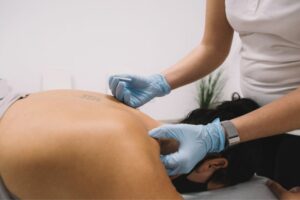
You might be familiar with the term “dry needling” and curious about its purpose or suitability for you. Despite its somewhat daunting name, dry needling is a widely available therapy aimed at alleviating muscle, ligament, or tendon discomfort.
Basics of Dry Needling
In the practice of dry needling, slender, single-filament needles are carefully placed into targeted muscle trigger points. These trigger points refer to localized areas of tense, irritated, and dysfunctional muscle tissue, commonly arising from factors such as injury, repetitive strain, or incorrect movement patterns.
Trigger points have the potential to disrupt muscle functionality, impede range of motion, and induce sensations of pain and tenderness. Chiropractors conduct a thorough assessment to ascertain the suitability of dry needling. This involves evaluating symptoms, assessing mobility, and scrutinizing muscle function to determine the role of trigger points in symptom manifestation.
When dry needling targets a muscle or trigger point, it can alleviate tightness, boost blood circulation, and alleviate pain. Many patients experience immediate relief post-treatment. The needles typically remain in the muscle for a brief duration, ranging from 10 seconds to 20 minutes, depending on factors like treatment location, number of needles, and treatment objectives.
Dry needling is commonly complemented by exercise and other chiropractic methods to prevent trigger points from recurring.
Unlike needles used for injections, dry needling employs solid needles that do not introduce any liquid into the body, hence the term “dry.” This technique shares similarities with various forms of acupuncture, all of which also use dry needles.
Dry needling proves to be a secure method for addressing numerous musculoskeletal issues. These encompass shoulder pain, rotator cuff pain, biceps tendinitis, iliotibial band syndrome, Achilles tendinitis, low back pain, tennis elbow, whiplash, neck pain, headaches, muscle strains, hip pain, and temporomandibular pain, commonly known as TMJ.
This procedure is administered by chiropractors and licensed acupuncturists who have undergone specific training. Certification prerequisites differ depending on the state. The majority of individuals undergoing this treatment report experiencing minimal discomfort or none at all.
Dry Needling and Acupuncture
Dry needling and acupuncture share certain parallels in their approach to treatment. Both modalities involve the insertion of thin needles at different depths to address symptoms. Additionally, practitioners often employ gentle movements or manipulations of the needles during the process. Typically, these methods are deemed to be secure and are typically integrated into broader treatment strategies. They enjoy widespread acceptance among practitioners of conventional or Western medicine.
Nevertheless, notable distinctions exist between acupuncture and dry needling. Acupuncture boasts a rich history dating back approximately 3,000 years within traditional Chinese medicine, and its efficacy has been extensively researched and documented.
Acupuncture, an ancient practice, aims to harmonize the movement of essential energy, referred to as chi or qi, believed to traverse the body via meridians.
Through precise needle insertion along these pathways, trained acupuncturists endeavor to restore balance and facilitate healing. Typically, multiple needles are utilized in a session. This therapy addresses a broad spectrum of ailments, encompassing pain, fatigue, infertility, headaches, insomnia, anxiety, and depression.
In contrast, dry needling is a more contemporary approach that has emerged in recent decades. Its focus lies primarily on alleviating musculoskeletal and neuromuscular discomfort by targeting trigger points within the muscles. While acupuncture seeks to rebalance energy circulation, dry needling concentrates on releasing tension in dysfunctional muscle points.
Dry needling treatment utilizes a reduced number of needles, frequently coupled with electrical stimulation to amplify its efficacy. This dual approach induces a mild contraction and release in the tense muscle, facilitating further relaxation.
If you’re grappling with muscle, tendon, or ligament discomfort, consult your primary care provider. Collaboratively, you and your healthcare team can assess whether dry needling aligns with your needs. As with any medical intervention, careful consideration is paramount prior to commencing dry needling.

At Precise Chiropractic & Rehabilitation, Dr. Hands, your dedicated chiropractor, is committed to relieving your pain and enhancing your quality of life.
Contact Us!
Precise Chiropractic & Rehabilitation
2191 Defense Highway, Suite 222
Crofton, MD 21114
Phone: (410) 370-0600
Opening Hours
| Monday | 12:00pm | 6:00pm |
| Tuesday | 7:30pm | 2:00pm |
| Wednesday | By | Appointment |
| Thursday | 12:00pm | 6:00pm |
| Friday | 7:30am | 2:00pm |
| Saturday | Closed | Closed |
| Sunday | Closed | Closed |


